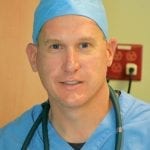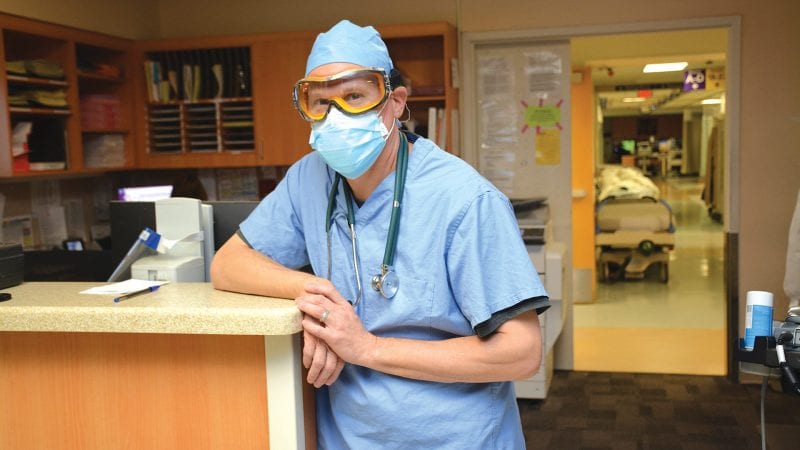Non-COVID-19 Hospital Visits Plummet — and That’s a Problem
Don’t Ignore the Signs
By JOSEPH BEDNAR
Dr. Mark Kenton wonders where all the appendectomies have gone.
“People are sitting at home with belly pain and gallbladder issues, and they hear the CDC say to stay with social distancing, so they stay home and get sicker,” said Kenton, chief of the Emergency Department at Mercy Medical Center. “They might not be seeking help they actually need. That concerns us.”
And it’s not just belly pain; the entire Mercy ER has seen patients of all kinds — except those presenting with COVID-19, of course — stay away.
“We’ve had a really significant decline in volume,” Kenton told HCN. “We probably average about 220 to 240 a day — during peak flu season, it was around 280 a day — but with this, we’ve dropped down to an average of about 115 to 120 a day, with our lowest day at 75.
“It’s really a national trend,” he added, noting that people took to heart guidance, early in the pandemic, to visit the ER for coronavirus only with shortness of breath or other clear COVID-19 symptoms. But that never meant staying away when an actual emergency arose.
“That scared people off from coming into the Emergency Department, those who need it for other reasons, and I think there’s a fear out there that, if you come to the hospital, you’ll be exposed to COVID,” he explained. “But, really, there’s a very low chance of getting COVID. If you have to come to the ER with another problem, the message I’m trying to get out is, it’s still safe.”
Nancy Shendell-Falik, president of Baystate Medical Center in Springfield, joined a handful of other hospital executives at a press conference with Gov. Charlie Baker late last month about the sudden drop in ER traffic. At the time, Baystate was using only 550 of its 1,000 beds — 150 for COVID-19 patients and 400 for other patients. The hospital had just seen an 80% decline in patients with stroke symptoms from the previous month.

“People are sitting at home with belly pain and gallbladder issues, and they hear the CDC say to stay with social distancing, so they stay home and get sicker. They might not be seeking help they actually need. That concerns us.”
Statewide, Baker said, more than half of the 18,000 available hospital beds statewide were empty. Michael Apkon, president and CEO of Tufts Medical Center, added that “it is true we are quite busy caring for patients with COVID-19, but we have a growing concern about what we’re not seeing.”
Kenton agrees. “The biggest concern is, a lot of patients in this community have no primary-care provider and have no insurance. We’ve become a safety net for a lot of them, and it’s concerning when people are sitting at home with chest pains, or they have a heart attack or a stroke, and five days previously they had symptoms, and now there’s only a little you can do.”
Thoughtful Approach
Deborah Bitsoli, president of Mercy Medical Center, said people need to know it’s safe to seek essential treatment. “In line with our core value of safety, we are taking a thoughtful, phased approach to resuming select services and are following CDC and state COVID-19 guidance to provide a safe environment for patients and colleagues.”
That includes establishing COVID-free zones, which are areas where care is provided only for people not known to have COVID-19 symptoms; as well as screening and testing all patients, colleagues, and approved visitors; providing and requiring masks for everyone in the facilities; and following CDC standards for more frequent deep cleaning, paying special attention to doorknobs and flat surfaces that are frequently touched.

In addition, all patients scheduled for procedures requiring an overnight stay will be tested for COVID-19 within 24 hours prior to the surgery or procedure. If a patient tests positive, the procedure will be postponed until a negative result is obtained. At the time, if there is a negative test result, the procedure will continue as planned in a COVID-free zone.
COVID-19 patients, Kenton added, “are really segregated and separated from other patients that need different types of care, so it’s a safe environment for people to come to.”
It’s not just hospitals being vigilant. The Baystate Regional Cancer Program is conducting universal screenings of anyone who enters its treatment facilities, including patients, visitors, employees, and clinical staff members. These screenings include questions to see if those who enter have symptoms of COVID-19 and a temperature check.
For those at high risk for contraction of COVID-19, the team may delay or adjust elements of their care to ensure their safety. The team is also offering telehealth visits where appropriate in order to reduce the number of visitors to the center and stay connected to patients.
“The personal connection really makes a difference for cancer patients, especially right now,” said Dr. Wilson Mertens, vice president and medical director of the Baystate Regional Cancer Program. “We are doing all we can to help relieve the additional stress and anxiety cancer patients may feel at this time, while providing the best possible treatments.”
That’s because cancer treatments are critical — but so are hospital visits for strokes, heart attacks, appendicitis, or any number of other conditions that haven’t suddenly gone away in Western Mass., despite what the decline in ER visits may suggest.
“I think it will be very interesting to see what the state reopening businesses will do to our volume,” Kenton said, noting that cases of COVID-19 might spike, but people may feel more free to be out in public as well.
“Will people feel more comfortable coming back to the hospital? We want to see outpatient surgeries and procedures up and running again, all those things hospitals do. But it’s just as important to continue social distancing, which I think we’re going to have to do for some time to flatten the curve.”
In Control
Kenton’s message is that it’s possible to do both — especially when those chest or abdominal pains arise.
“It’s definitely a difficult time. We’ve had to adapt and adjust and change — none of us alive right now have been through something like this. It’s new for everyone, and we’ve had to be creative and respond to this in a calm and logical manner.
“We know there are fears,” he went on. “If you focus on what you’re seeing on the news on a daily basis, that will bring up significant fears and anxieties, which make your overall situation seem worse. But you can only control what you can control. As medical director, I’m focused on keeping my staff and patients safe; that’s how we’ll get through this. Control what you can control.”
And don’t be afraid of the emergency room.




